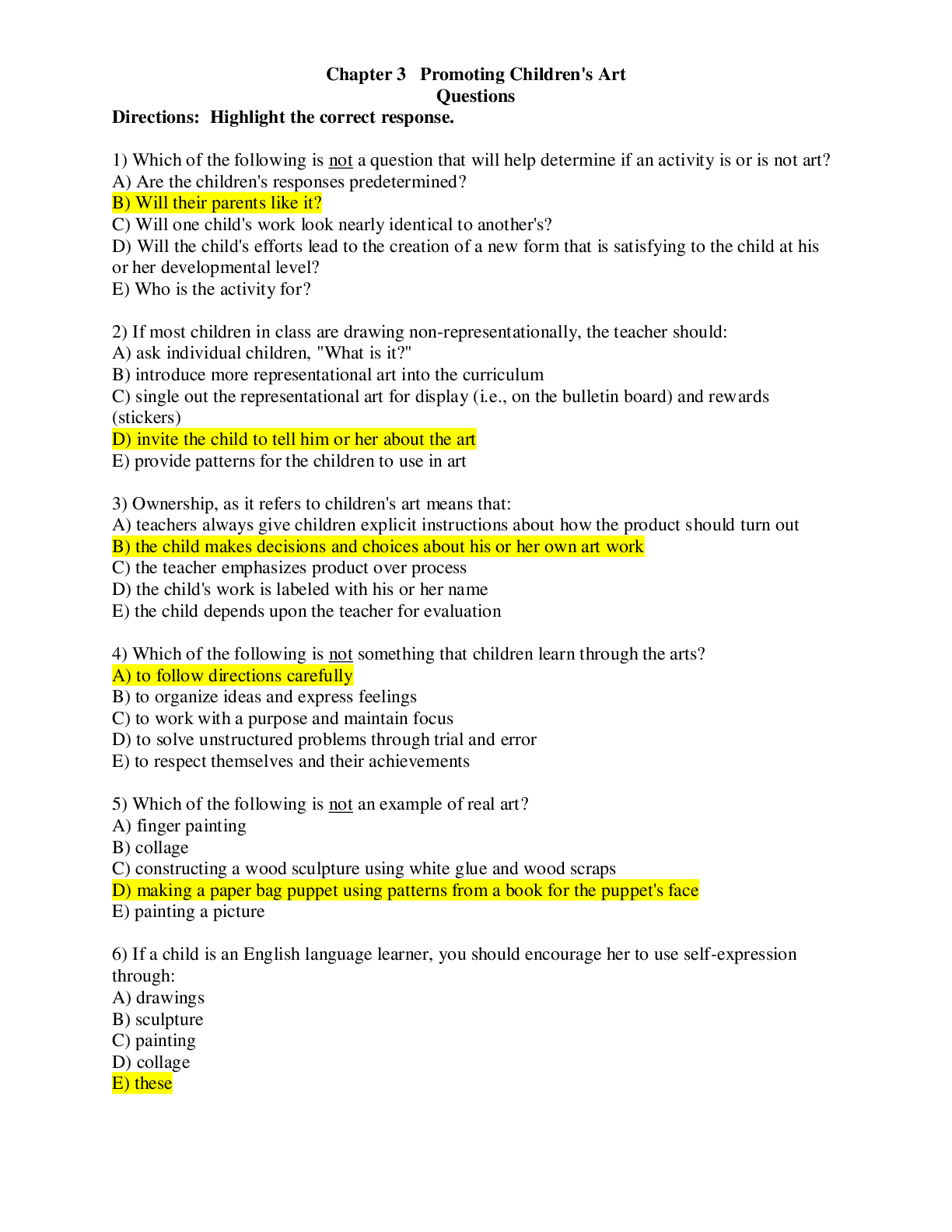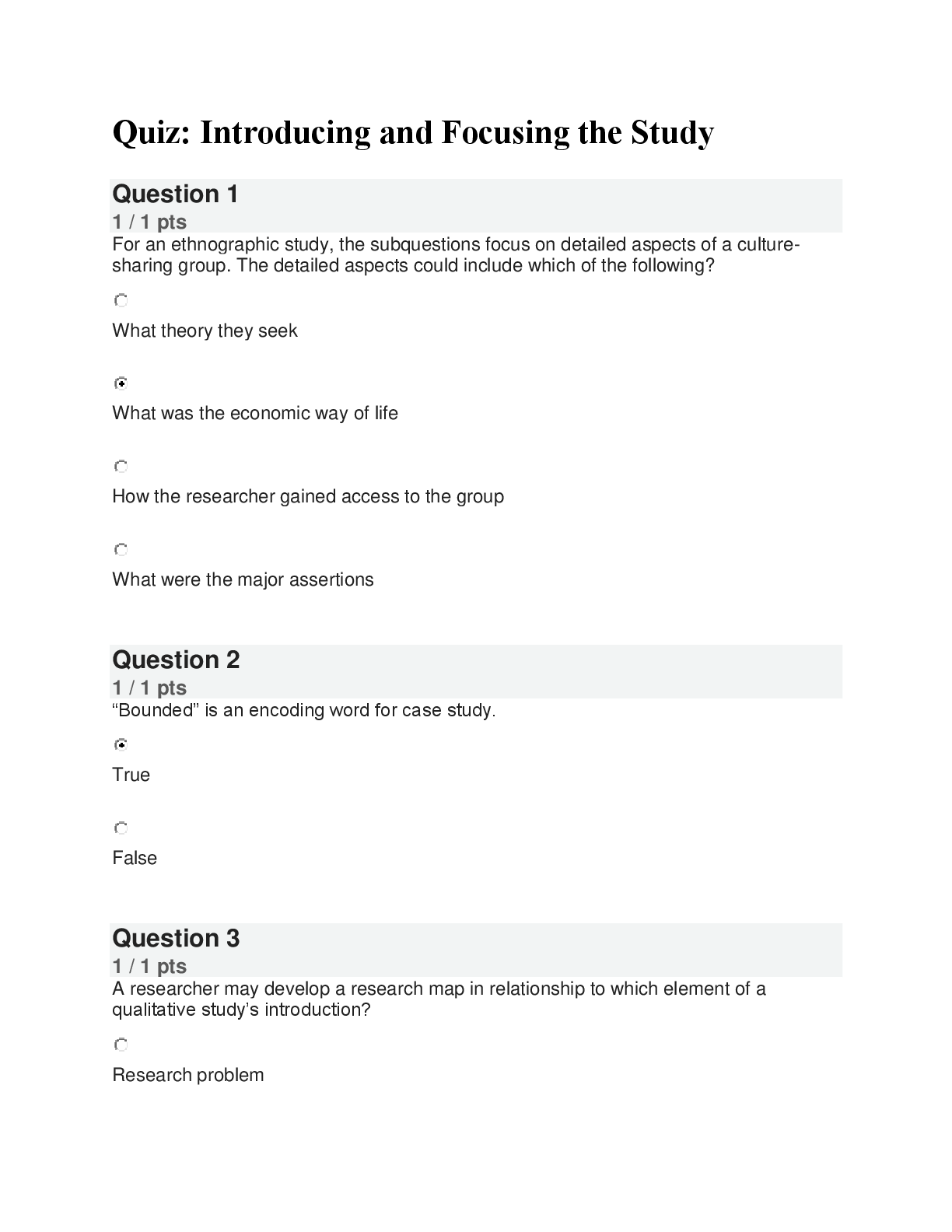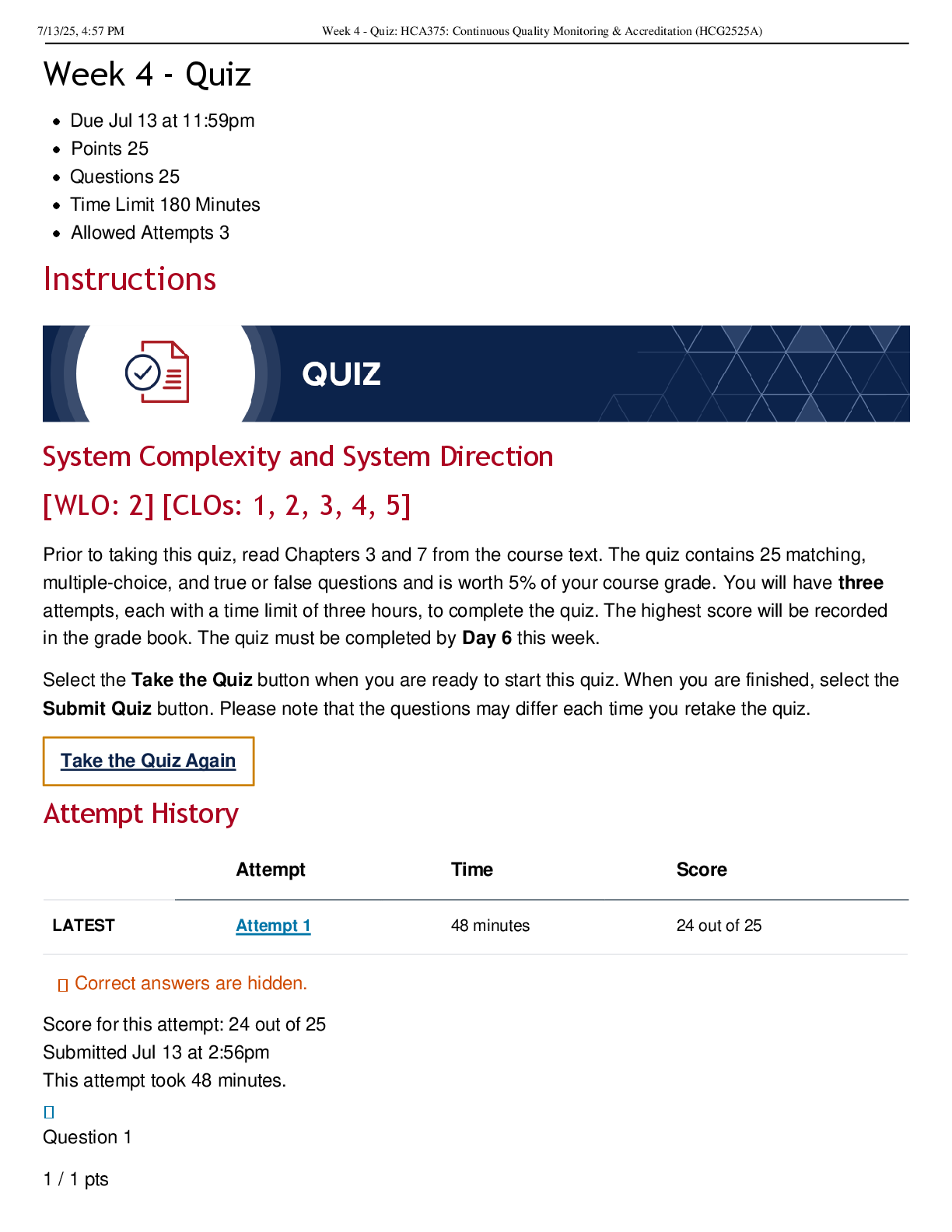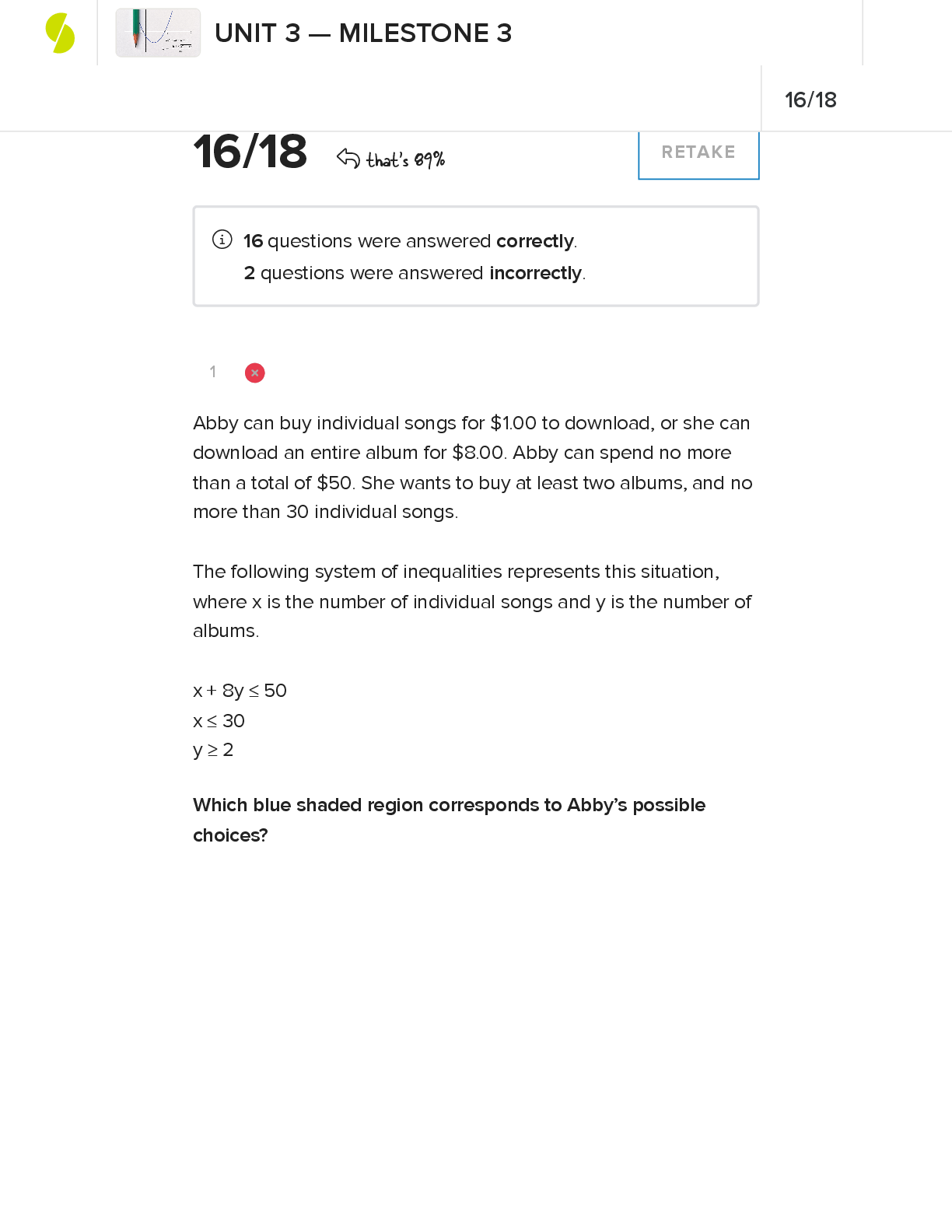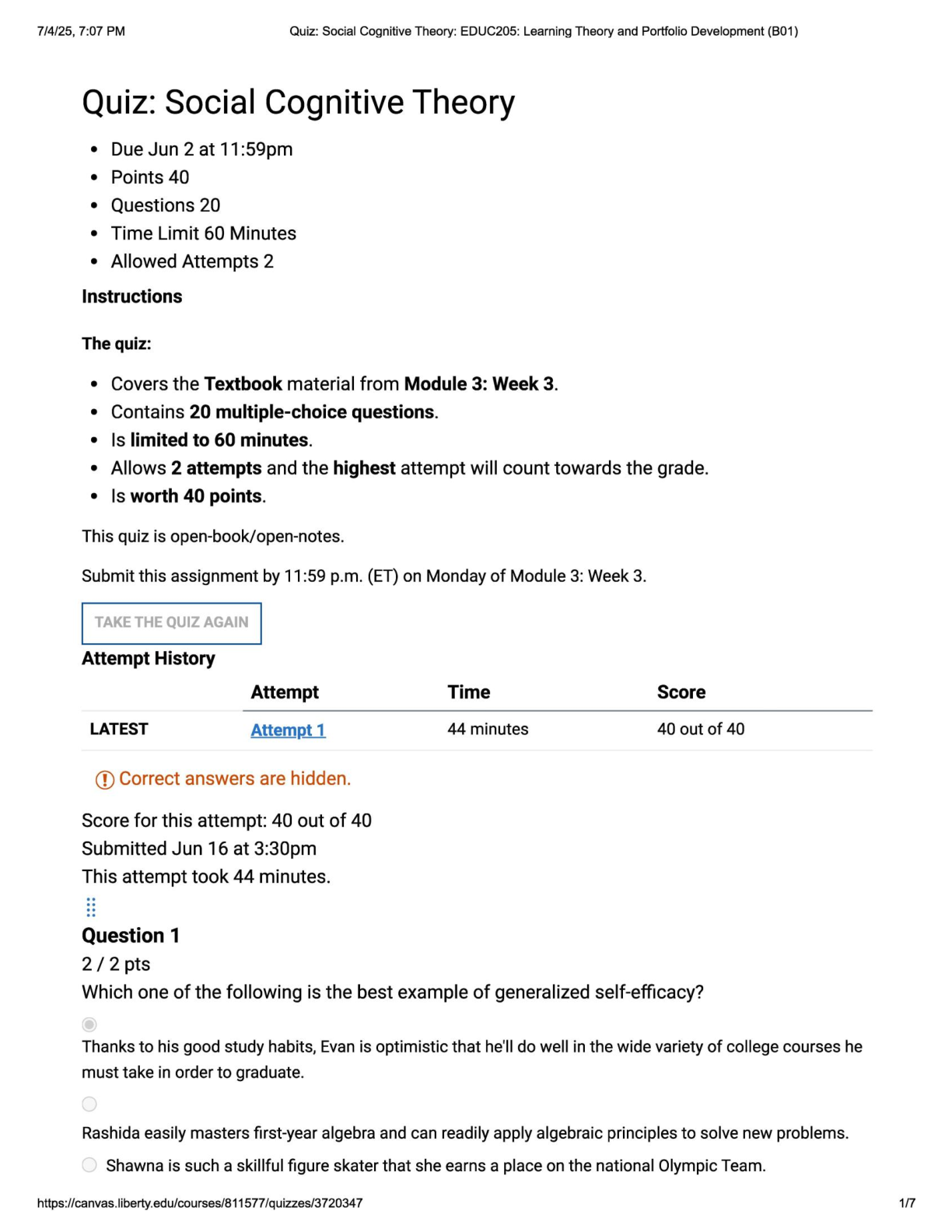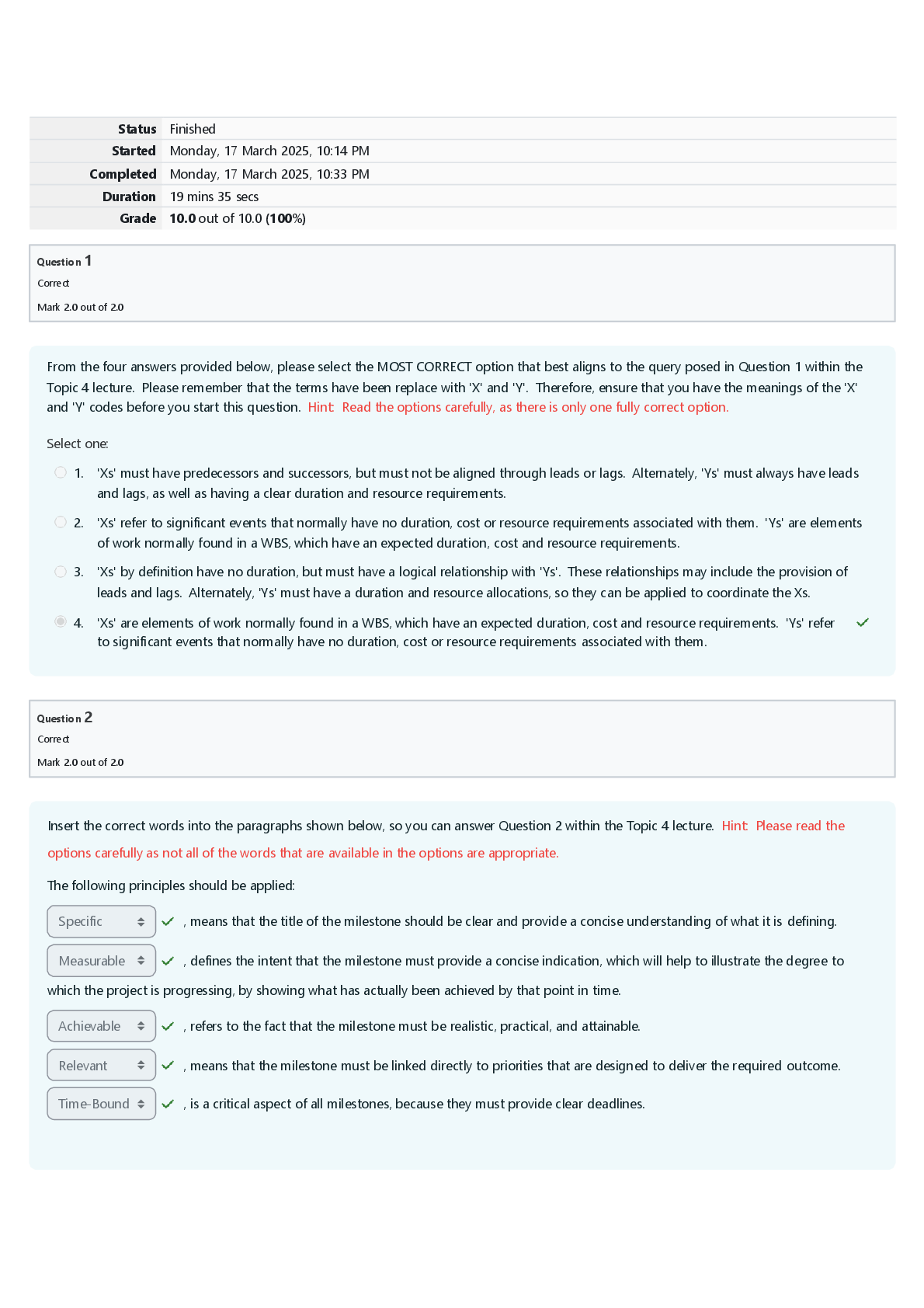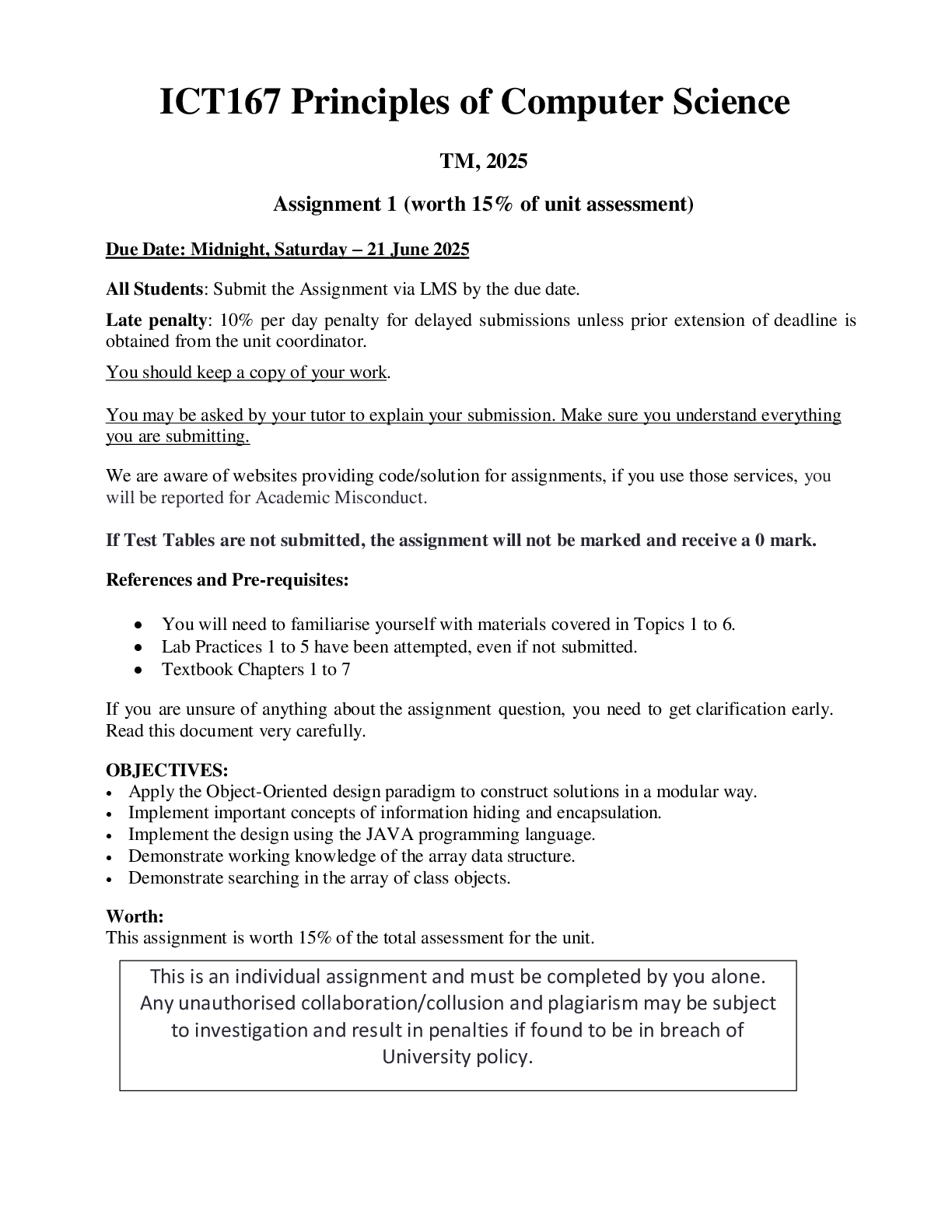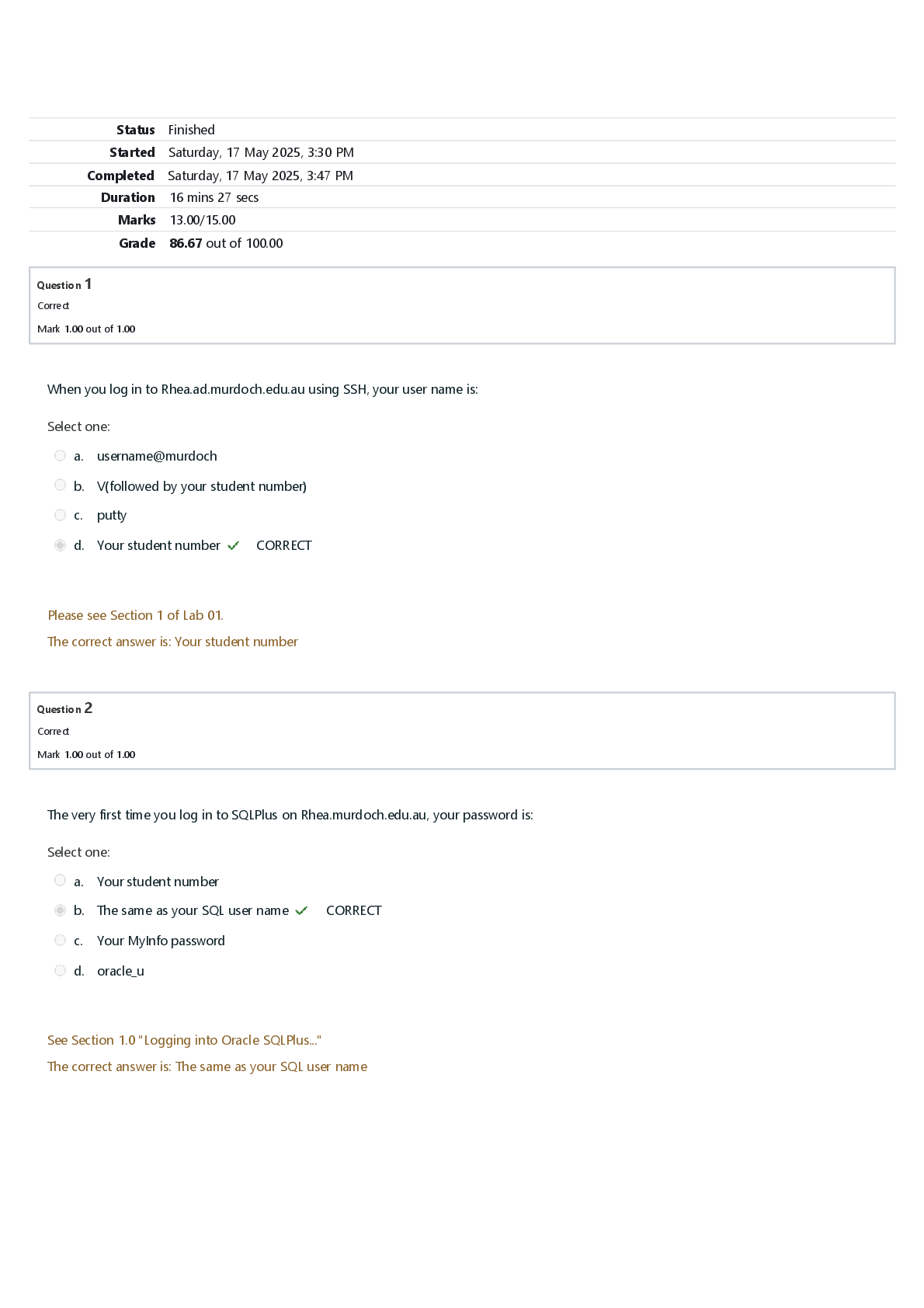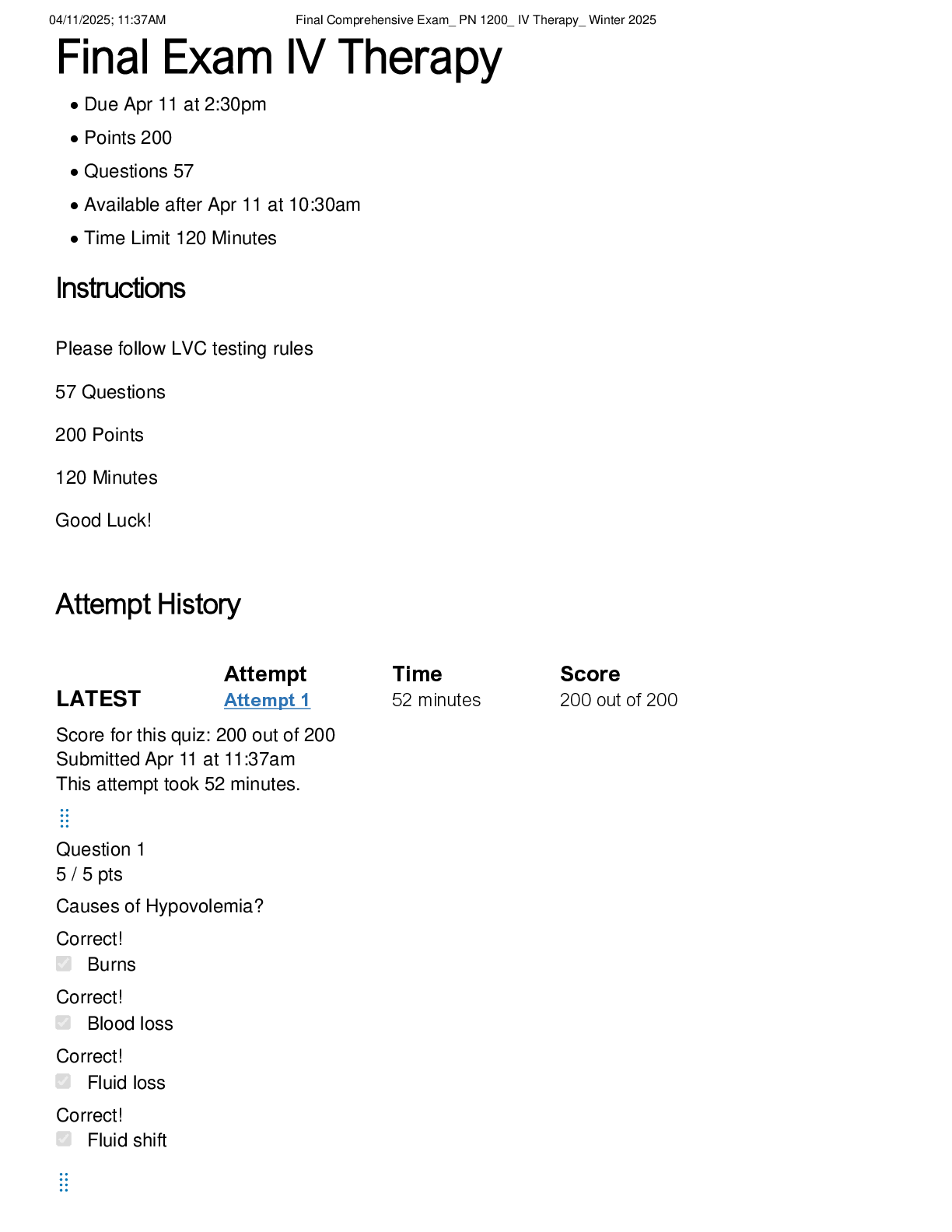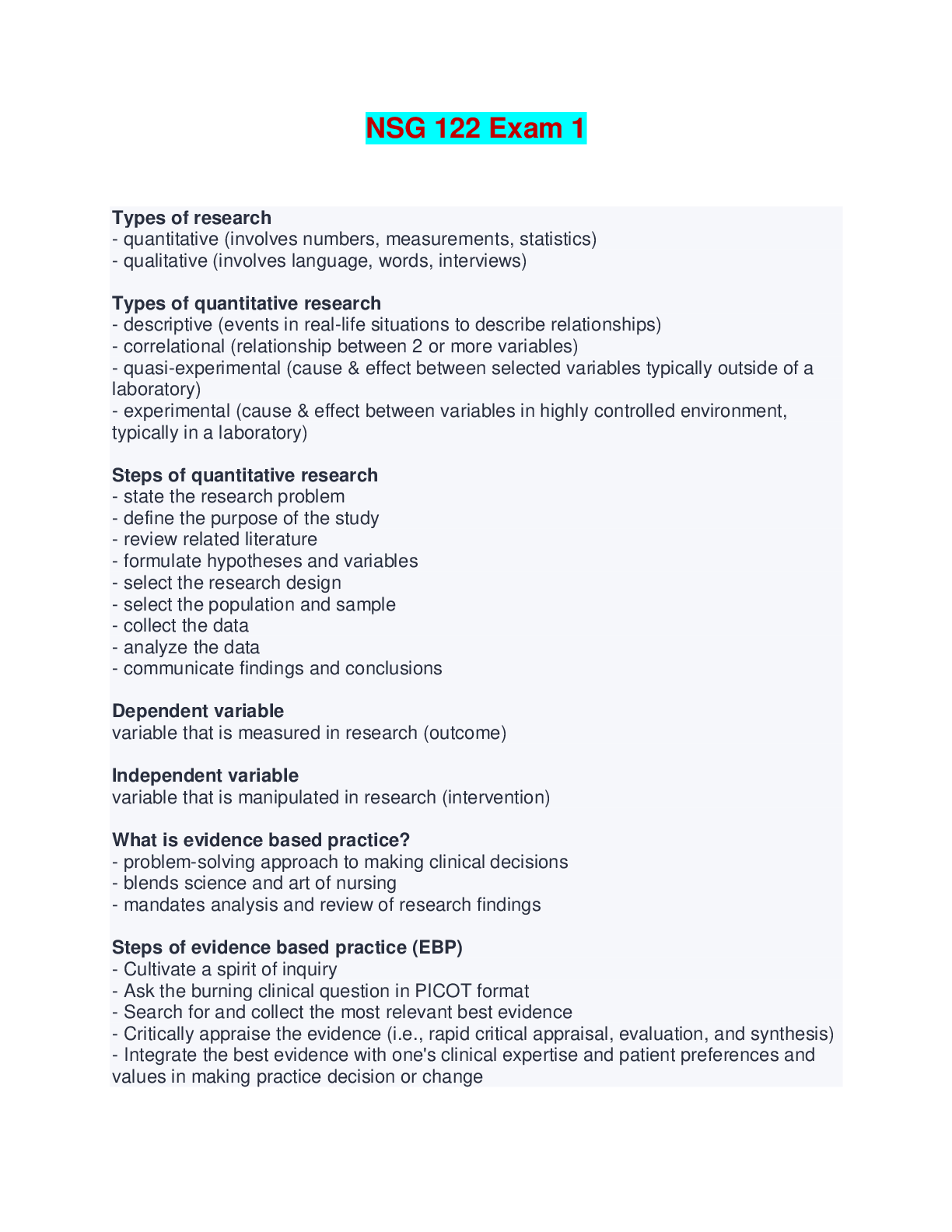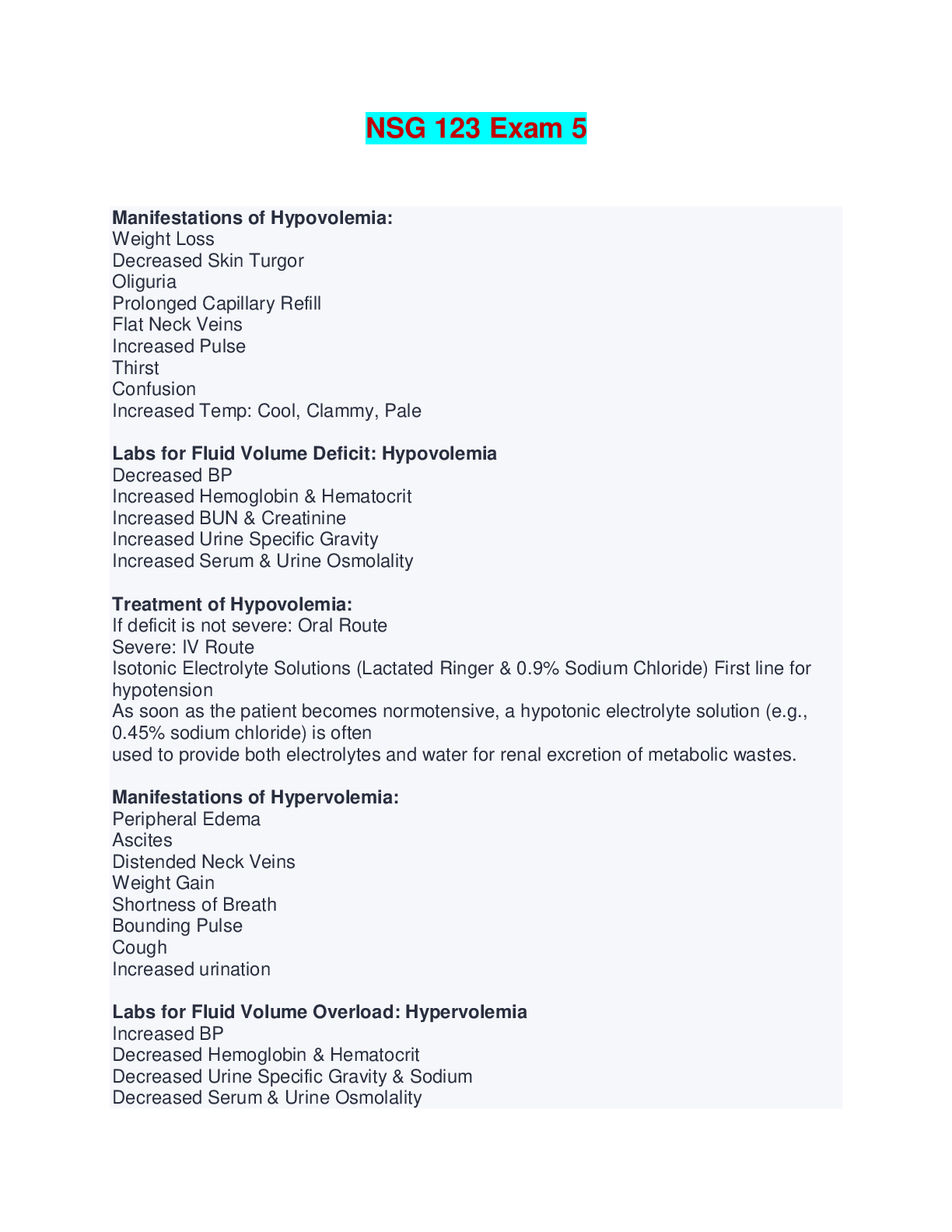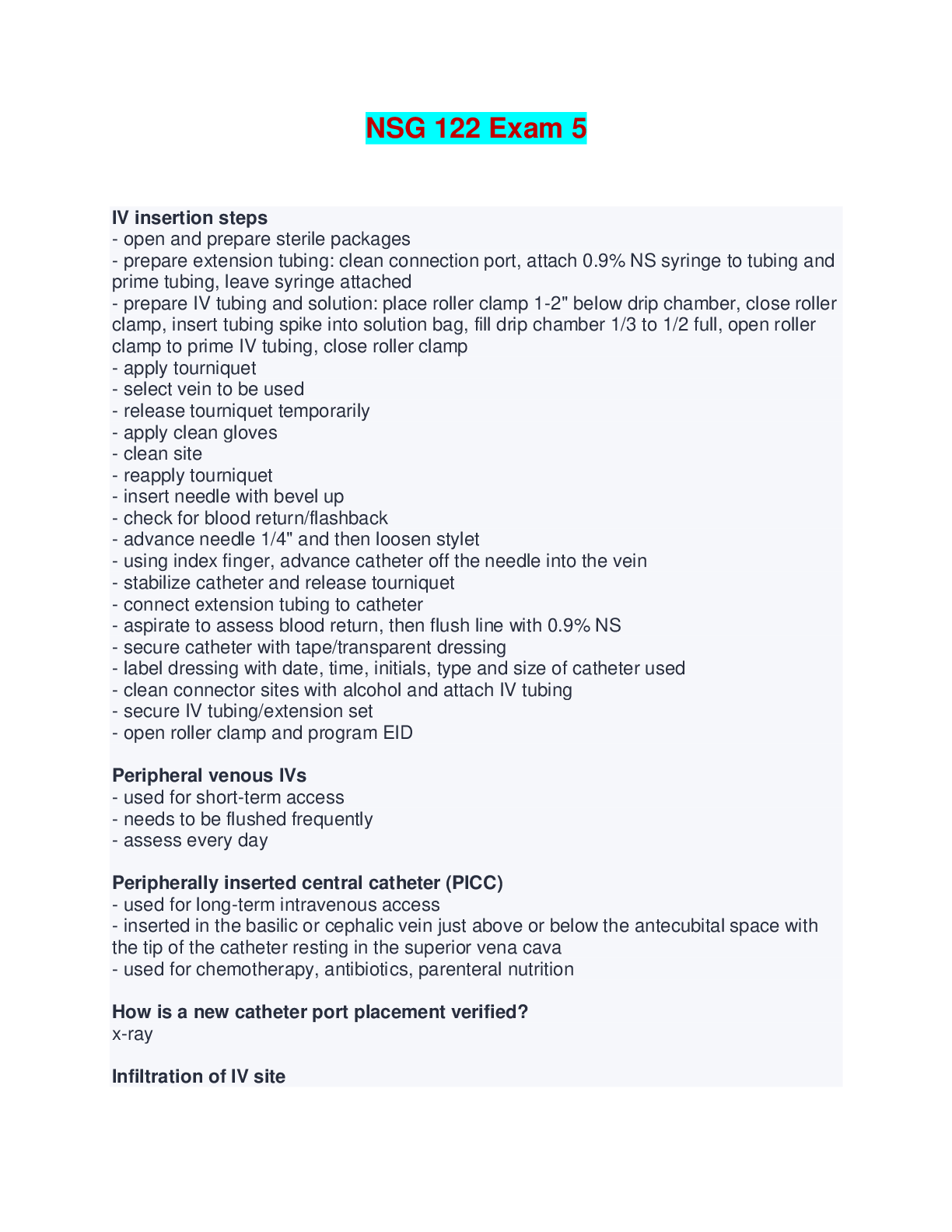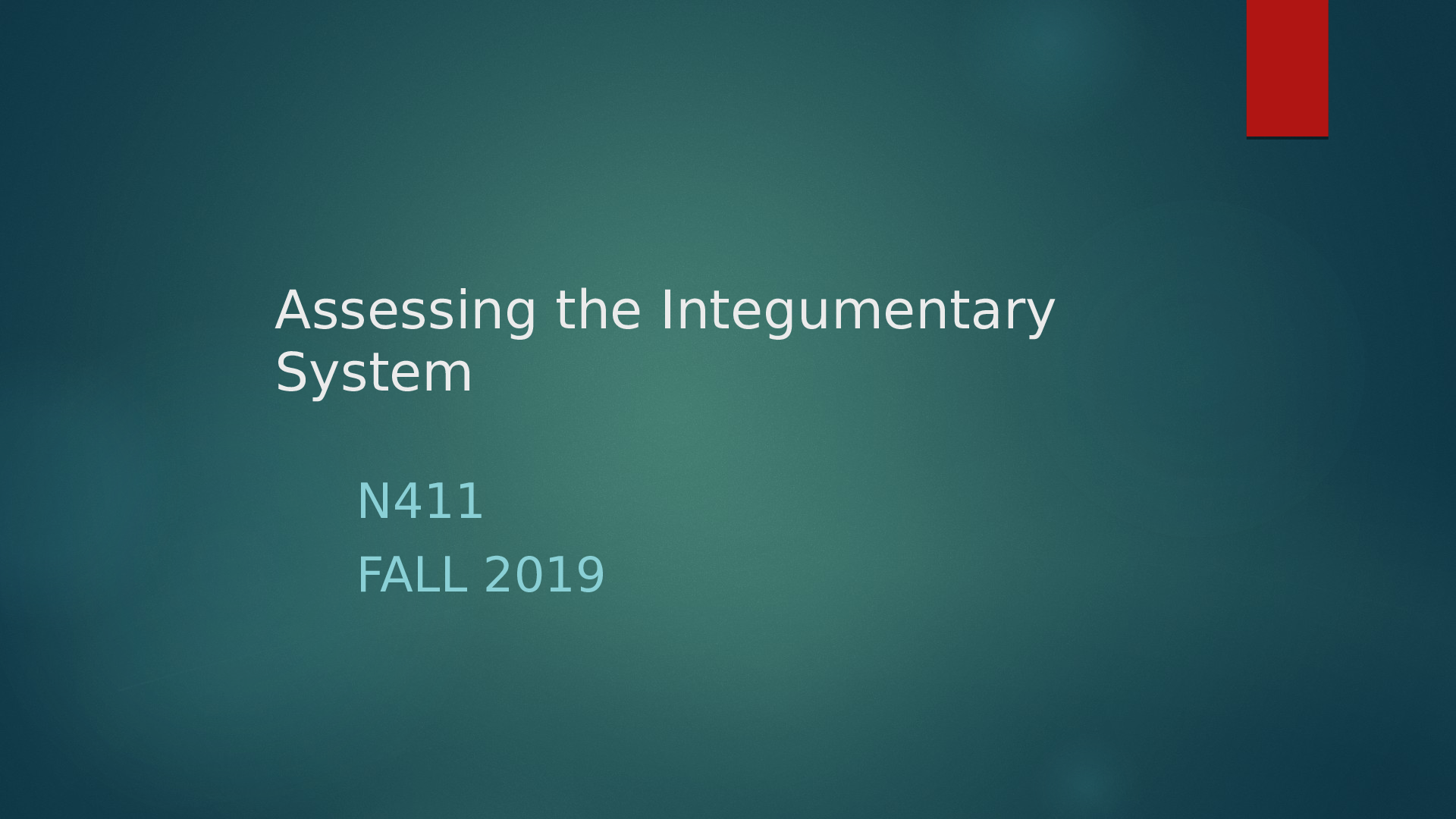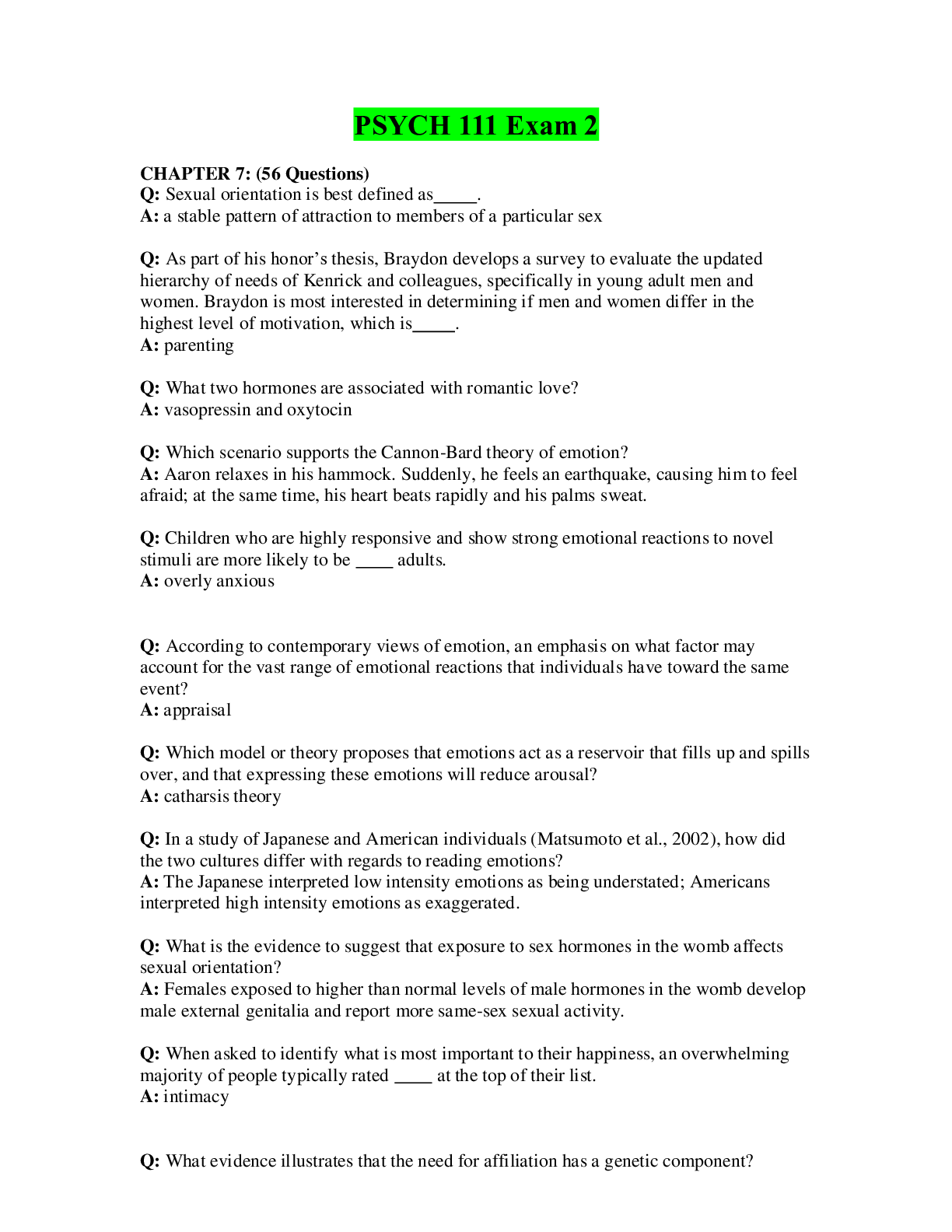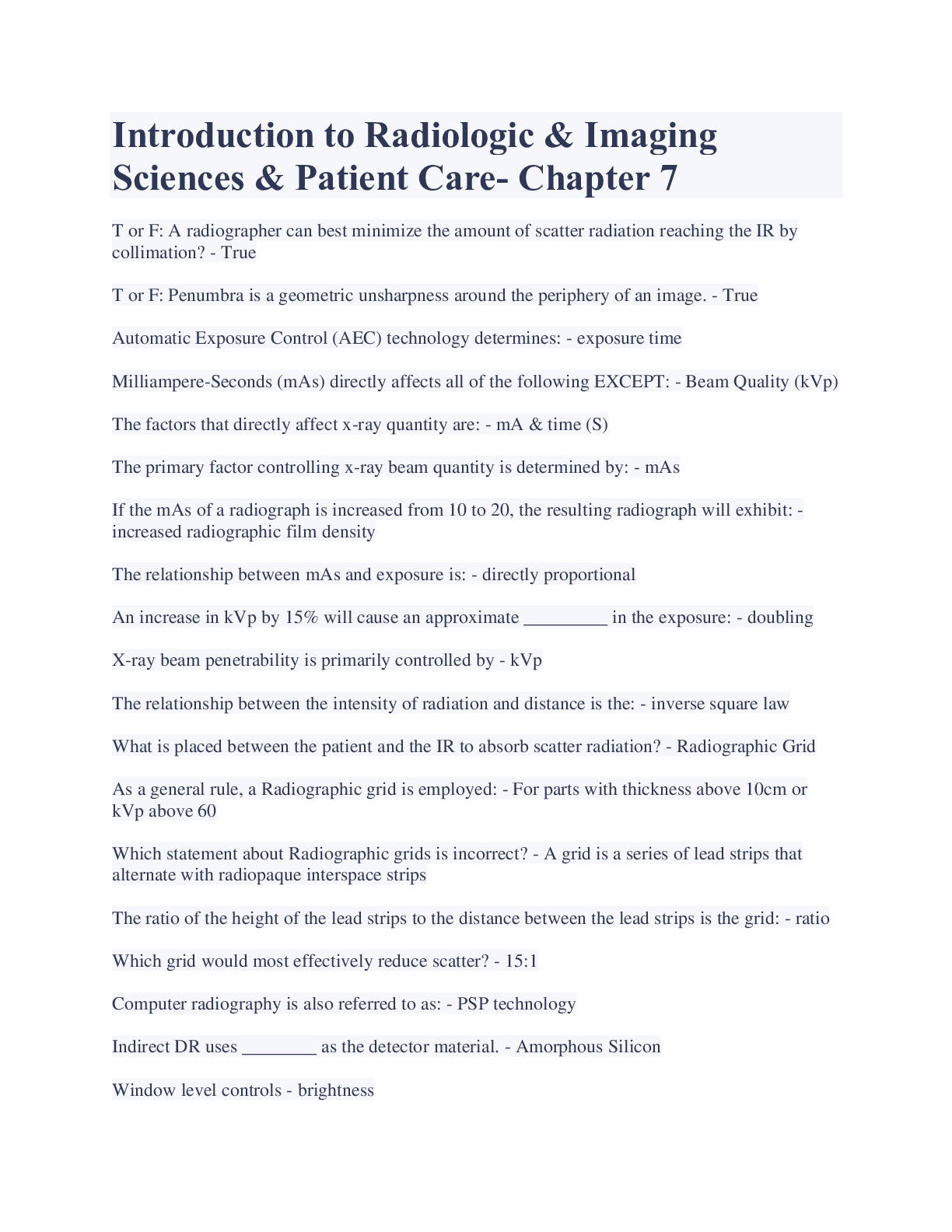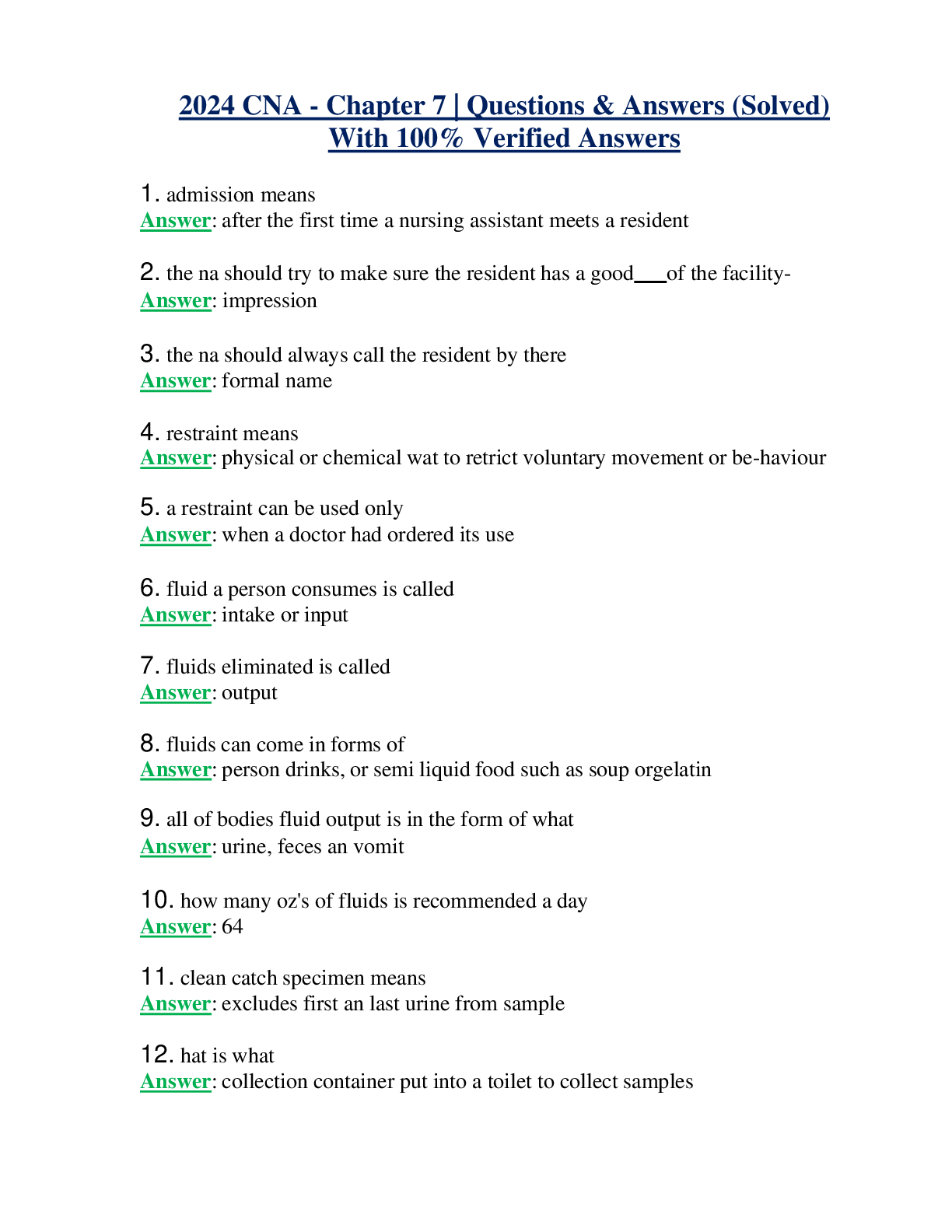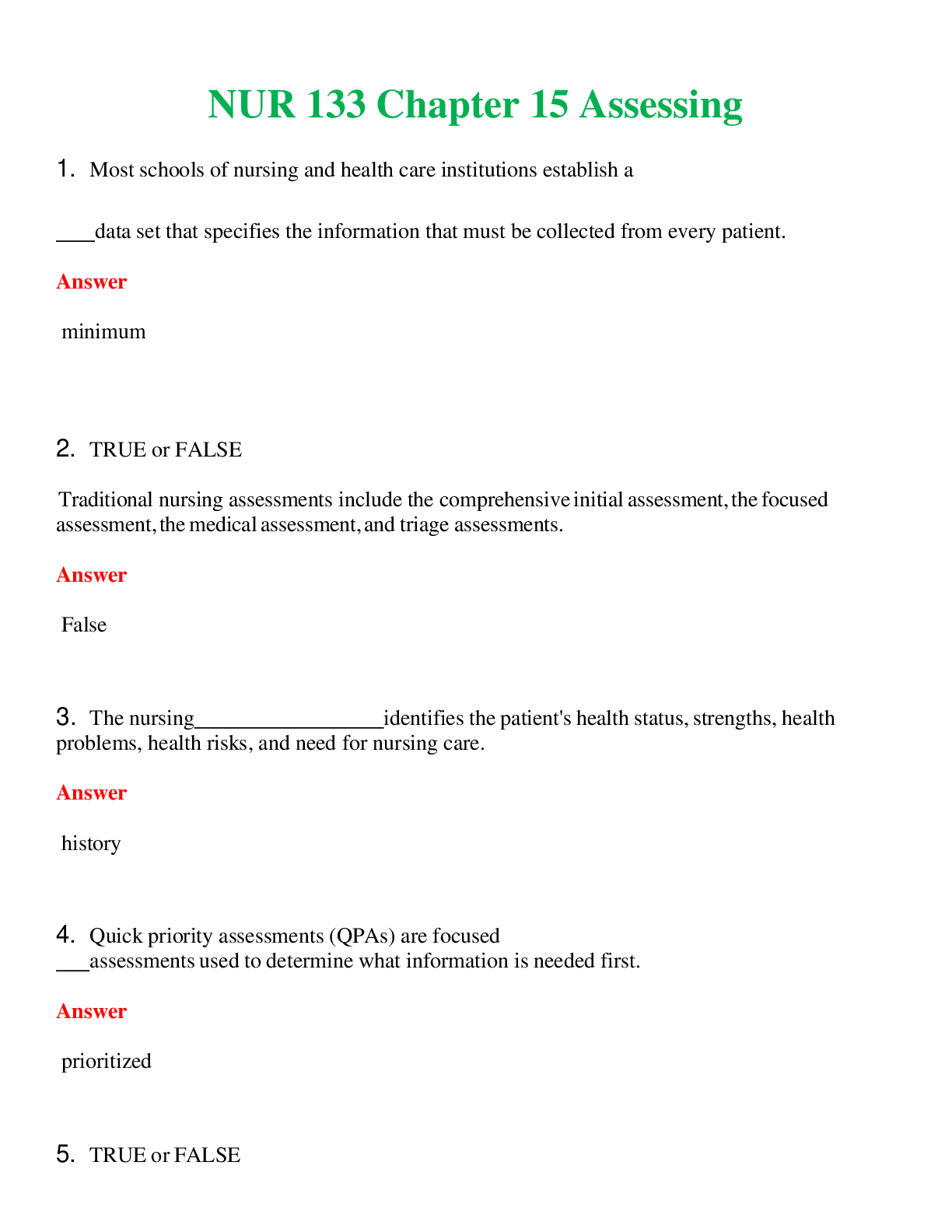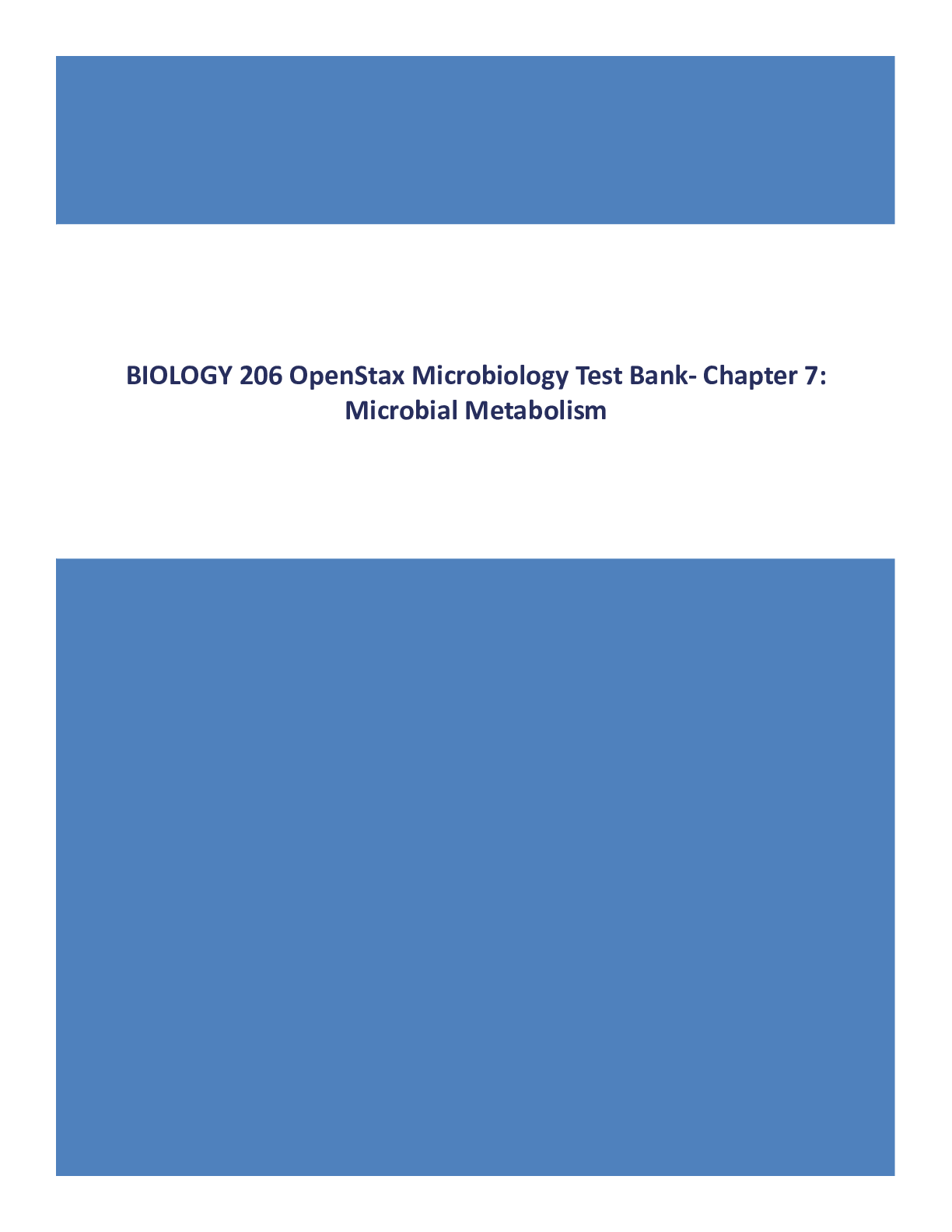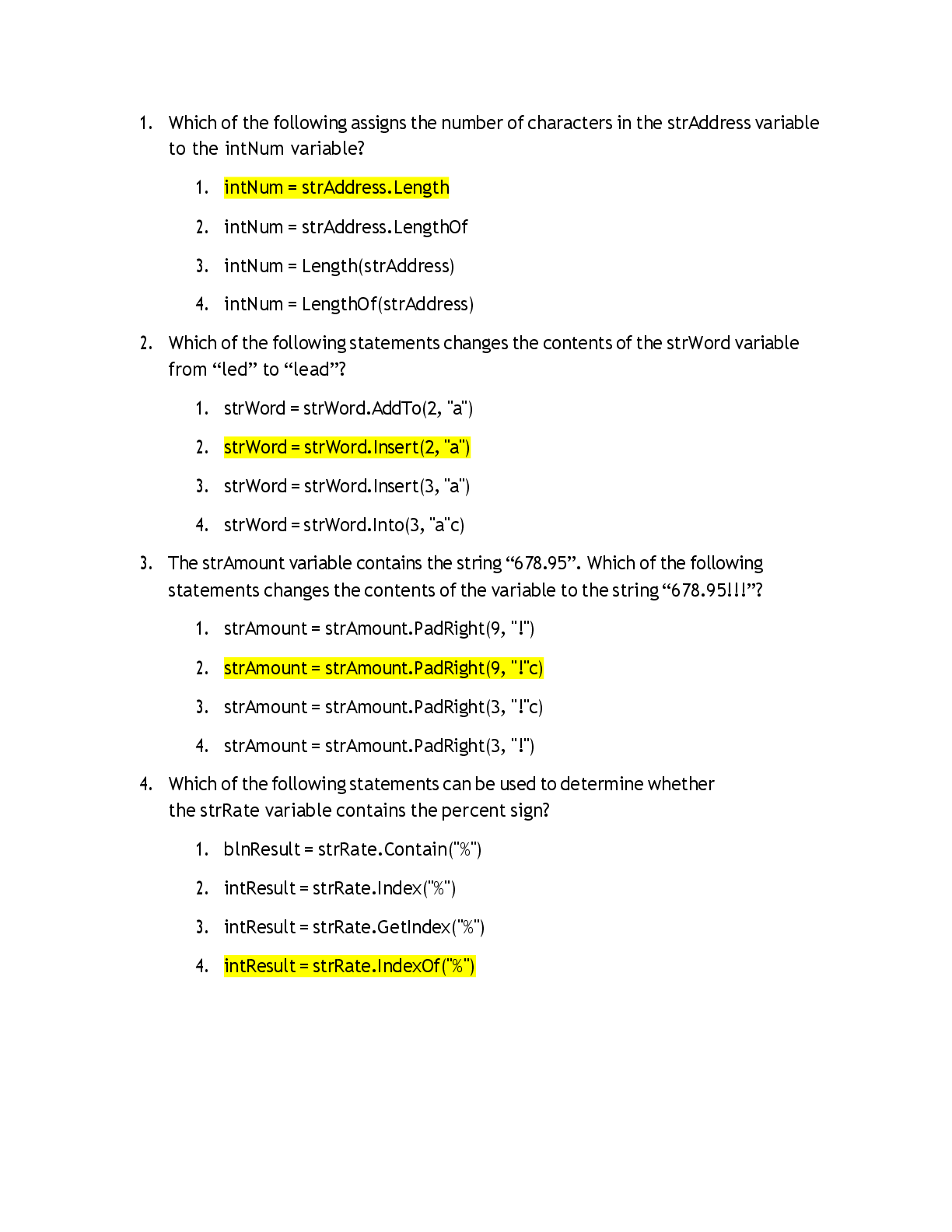ECDI 2271 - Chapter 7 Assessing the Creative Processes and Products of Children
Document Content and Description Below
Chapter 7 Assessing the Creative Processes and Products of Children 1) ________involves the process of discovering a child's knowledge, abilities, and interests. A) Performance assessment B) A teacher... made test C) Curriculum D) Standardized testing E) Informal testing 2) One of the most valuable assessment tools available to teachers is: A) a standardized test B) a teacher made test C) formal testing methods D) observation E) intelligent tests 3) All of the following are reasons for conducting assessments except: A) to make instructional decisions B) to identify needs of individual children C) to rank and separate children according to ability D) to improve educational programs 4) Which of the following are reasons for assessing divergent/lateral thinking? A) to determine the impact of an educational program on young children's growth in creative expression and play B) to identify talents C) to provide enrichment and develop potential through special programs D) to develop intervention strategies E) all of these 5) All of the following practices support gifted and talented students except: A) pull children to participate in gifted programs B) use flexible grouping strategies that respect competency in each subject C) do not force children to study material they have mastered D) recognize the unique needs of gifted students E) seek ongoing professional development that addresses the needs of all learners 6) Which of the following are considered to be child-centered assessment strategies? A) portfolios B) teacher interviews with students C) anecdotal records D) documentation panels E) all of these 7) A good observation should include: A) high inference appraisals of children's behavior B) terminology that labels the child C) a detailed description of the context in which the behavior occurred D) very general information E) criticisms of the child and family 8) In the product-oriented approach to creative assessment, products are evaluated based on: A) The creativity of student's work B) Practical workability C) How hard the child worked D) Aesthetic appeal E) How closely the product resembles a model 9) When writing letters to families, it is important that educators do all the following, except: A) write in clear, simple language B) include detailed lesson plans C) provide concrete examples D) explain what children are learning and how parents can help E) use a positive tone 10) Which of the following are part of documentation process? A) setting a purpose B) selecting methods, tools, timing C) analyzing the data D) formulating a response E) all of these 11) Appropriate observations of children do the following: A) include high-inference, value laden terminology B) record inferred behaviors C) lack details of the context in which the behavior occurred D) become the basis for planning a high quality program E) all of these 12) An example of an assessment method produced and assessed by the children includes: A) self-selected work samples B) teacher-led interviews with children C) child-led conferences D) B and C E) A and C 13) Which of the following supports children's creative thinking? A) Let's look at these two pictures. B) What did you think of the story? C) What do you predict will happen when…? D) How do you know that is true? E) What colors did you use in this picture? 14) Assessment of creative thinking and arts-based learning should help teachers to: A) identify and respond appropriately to the needs of individual children B) make instructional decisions that benefit the child C) evaluate program effectiveness D) all of the above E) A and B 15) Appropriateness of creative work can be assessed with the following evaluation questions: A) Did the student like the activity? B) Did the student fulfill the lesson objective? C) Did the student finish the activity? D) How did the child deal with challenges and frustrations? E) A and C F) B and D 16) Robinson highlights that one of the challenges with creativity is: A) allowing kids to be creative B) creativity is worthwhile C) assessing the value of creativity D) guiding children's creative projects 17) A purpose for using anecdotal records includes: A) highlight student attitudes, preferences, judgments, and participation B) compare one child's progress with that of the typically developing child C) demonstrate their emerging understanding of creativity and the arts D) provide evidence of the learning that was achieved through the course of a major project 18) Which of the following should be considered in portfolio development? A) Competence, Cooperation, Collaboration, Cognition, Community B) Celebration, Cognition, Communication, Cooperation, Competency C) Communication, Collaboration, Celebration, Capability, Cognition D) Cooperation, Capability, Collaboration, Competence, Communication 19) Parents and families need to be involved in assessing children's growth. Teachers should foster this involvement by all of the following except: A) giving parents/families opportunities to provide written feedback on their children's work B) conferencing with parents/families regarding their children's progress C) permitting parents/families to visit the classroom only on special days, such as field trips D) having families review taped or individual performances of their children 20) When using performance assessment, it is advisable to: A) Try to develop a "snapshot" of the student's knowledge B) Emphasize intellectual ability only C) Select interesting tasks D) Use the results to make informed instructional decisions. E) A and B F) C and D 21) Anecdotal records highlight student: A) Behaviors B) Intelligence C) Lack of progress D) Participation 22) The following are all benefits of the use of portfolio assessment except: A) Portfolios reveal and document children's learning in several different modes B) Portfolios encourage self-evaluation by students C) Portfolios collect all of the child's work in one place D) Portfolios can guide instructional decisions E) Portfolios are immediately understandable by parents 23) Before leaving language arts class, the teacher asks students to discuss their role in group work completed that day. Why should a teacher spend time on this? A) It allows students an opportunity to use their verbal skills. B) Students can share what they learned with entire class. C) Students not only self-evaluate but also reflect on others' contributions to the group. D) A discussion is a good way to calm students before leaving the room. 24) Throughout the school year, a second-grade teacher uses learning centers during science. What is the best way to evaluate student learning during these activities? A) Observe students during center time to determine if they understand the science concepts. B) Wait until students complete activities and give them a written test afterward. C) Incorporate ways for students to record their observations; for example, a sink/float chart or a record of which items attracted/repelled a magnet. D) Have students write a sentence about what they learned at each center. 25) Creativity-Fostering teachers: A) Provide challenging and stimulating learning materials B) Are uncomfortable with ambiguity and only accept one solution to problems C) Create opportunities for students to create similar work with an expected outcome D) Consider themselves to be creative 26) A third-grade student with special needs seems to be disengaged from the project being completed in a small group. The teacher takes her aside and asks why she isn't completing the work. The student shares that she believes she isn't as smart as the other students and therefore has nothing to contribute to the group. How should the teacher respond? A) "I understand how you feel, but you have to complete your work anyway. If I let you drop out of the group, other children will want to also." B) "Yes, you seem frustrated by this group work. Why don't you go and work at the computer by yourself?" C) "People are smart in different ways. I know that your classmates admire your ability to draw. Maybe that is your way to help the group." D) "I see your frustration; I'm sorry that you are having a bad day." 27) A teacher asks her second graders to paint a picture at four different times throughout the school year and place them into a portfolio. What would be the primary goal of this approach? A) Collecting information from different sources using different methods B) Using data to guide instructional planning C) Keeping the children occupied so that they behave themselves D) Using ongoing assessment to document growth and progress 28) A first-grade class was learning to mix colors to make another color. The teacher asked the children to draw leaves and then paint the leaves using secondary colors that were produced by mixing two primary colors. Simon excelled at creating the correct color but he had trouble cutting his drawing into anything that looked like a leaf shape. The teacher should assess this project on: A) neatness B) skill in using scissors C) attitudes toward art D) mixing the correct colors to create a new color 29) After sharing preschoolers' art portfolios during teacher/family conferences, a teacher sends the portfolios home so that families can see how their children progressed over the year and keep samples of their children's creative work. This method demonstrates: A) cognition B) communication C) cooperation D) competency 30) When a child shared the guidelines for entering the science fair and the project she envisioned with her parents and family, they had many questions for her. They asked her how she came up with the idea for the project, what challenges she foresaw, and what she did to overcome those obstacles. They also talked to her about what she might do differently next time if pursuing this project again. By discussing these things, the parents were: A) Building her self-evaluation skills B) Ruining her self-esteem C) Trying to act like teachers D) Discouraging her from participating in science fairs 31) Use the following choices to answer the items below. A. conference notes B. checklists, developmental profiles, or logs C. interviews with children D. documentation panels E. anecdotal records 1. ___B____ Demonstrate student understanding of creativity and the arts. 2. ___A____ Highlight student attitudes, preferences, judgments, and participation 3. ___C____ Include information gathered from individual or groups of children about the content and process of their creative work. 4. ___E____ Used to compare one child’s progress with that of the typically developing child. 5. ___D____ Provide evidence of learning that was achieved through the course of a major project. 32) Identify each of the descriptions below as applying to either: A. appropriate assessment B. inappropriate assessment 1. ___A____ Is product-oriented 2. ___A____ Involves a concrete, hands-on experience 3. ___A____ Recognizes the planning of curriculum as the main goal 4. ___A____ Drives the curriculum TRUE or FALSE 33) Good observations use indirect observational data. Answer: TRUE 34) Good observations accurately record only nonverbal observable behavior of the child. Answer: FALSE 35) Good observations describe the context—the time, setting, circumstances, and behaviors of other children or adults related to the episode. Answer: TRUE 36) Ideally, teacher observations should help teachers to plan and evaluate a developmentally appropriate program. Answer: TRUE 37) Published scales should be viewed as the ultimate indicator when assessing a child's play. Answer: FALSE 38) Play scales provide numerical information on cognitive and social dimensions of play. Answer: TRUE 39) Portfolios reveal and document children's learning in many different modes, on real world tasks, over an extended period of time. Answer: TRUE 40) Children's portfolios should not include every item ever produced by the child during the course of the year. Rather, they should be focused and organized by learning goals. Answer: FALSE 41) Every portfolio should include a table of contents so that teachers, administrators, parents, and children can make use of it. Answer: TRUE 42) When taking the role of "interactor," teachers should not intervene to help children's growth. Answer: FALSE 43) All structure, challenge, and assessment hinders a child's creativity. Answer: TRUE 44) Creative processes and products are multidimensional and complex. Answer: FALSE 45) Assessment should not focus on progress and effort because products are the only legitimate aspects of assessment. Answer: FALSE 46) Creativity is limited to the arts. Answer: FALSE 47) Creative thinking and children's art are poorly understood by teachers. Answer: FALSE 48) Creative thought and artwork are not adequately assessed by standardized tests. Answer: TRUE 49) Children's creativity must be assessed by specially trained teachers in art or music. Answer: FALSE 50) Creative thinking and artwork require real-life contexts to be valid. Answer: FALSE 51) Assessment of processes as well as content skills are important. Answer: TRUE 52) Teachers' approaches to assessment of children's creativity and artistic expression frequently match theory, research, and expert opinion. Answer: TRUE 53) Formative assessment occurs after the learning has taken place. Answer: TRUE 54) A child who performs a task earlier before most of her peers should be considered "advanced" even if she produces a stereotype. Answer: FALSE 55) Assessment should be directly linked to the objectives of the instruction. Answer: TRUE 56) All states in the United States have plans for systematic gifted education. Answer: FALSE 57) Assessment is an ongoing process rather than a single paper and pencil test. Answer: TRUE 58) Children should not make decisions regarding their portfolio; such decisions should be left up to the teacher. Answer: TRUE 59) In order not to hurt other children's feelings, teachers should not "single out" children who are talented. Answer: TRUE 60) Teachers should focus on children with learning difficulties because gifted children will perform fine on their own. Answer: FALSE 61) The most effective method to measure creative expression is with a paper-and-pencil test. Answer: TRUE 62) A good observer relies on high inference methods to understand a child's behavior. Answer: TRUE 63) Creative teachers establish a classroom climate that discourages alternative solutions. Answer: FALSE 64) A rubric is a particular type of rating scale that specifies the level of performance and links it to a grade. Answer: TRUE 65) Good observations include high-inference, value-laden terminology. Answer: TRUE 66) An intermediate student's creativity journal may be used to assess his/her creative growth. Answer: TRUE [Show More]
Last updated: 2 years ago
Preview 1 out of 8 pages

Buy this document to get the full access instantly
Instant Download Access after purchase
Buy NowInstant download
We Accept:

Reviews( 0 )
$12.50
Can't find what you want? Try our AI powered Search
Document information
Connected school, study & course
About the document
Uploaded On
Feb 26, 2021
Number of pages
8
Written in
Additional information
This document has been written for:
Uploaded
Feb 26, 2021
Downloads
0
Views
171
